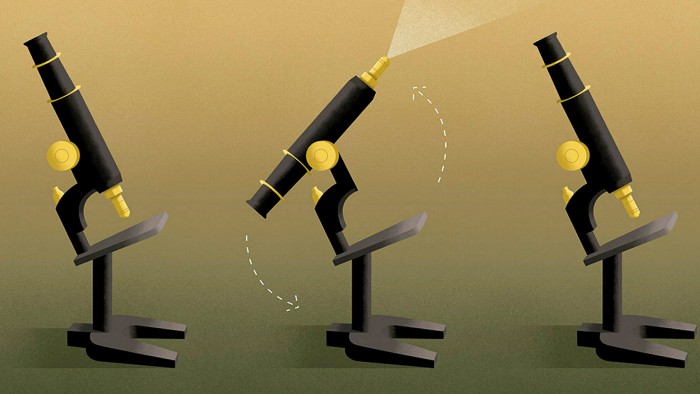To combat disease, science must look beyond the Kardashian of proteins


Roula Khalaf, Editor of the FT, selects her favourite stories in this weekly newsletter.
The writer is a science commentator
If there were a celebrity hierarchy of proteins, p53 would be its Kim Kardashian. The protein scuppers tumour growth: a lack of p53 — for example through a mutation in the gene that produces it — predisposes a person to cancer.
It is, therefore, the most exhaustively studied protein in the human body, with two scientific papers published on it per day. While p53 is unquestionably important to health, it is also a beneficiary of the “street light effect”, in which a phenomenon that is already illuminated attracts further attention (this bias is sometimes compared to a drunkard searching for their lost keys under a street lamp).
Now a consortium of researchers is assembling the Understudied Proteins Initiative to find the Cinderella proteins lurking beyond the limelight. “Our key goal is to provide a basic molecular characterisation of all human proteins and remove the barriers to studying them,” explains cell biologist Georg Kustatscher of Edinburgh university, who is helping to lead the Wellcome Trust-funded initiative and co-authored a paper on it for Nature Methods. Hundreds of scientists from labs all over the world have responded to the open call and a conference is planned for the spring.
Proteins are the fundamental building blocks of life. They make up our tissue and organs; they act, among other things, as enzymes, antibodies and hormones; they transport chemicals around the body. But scientists are still unsure exactly how many proteins make up the human proteome, the name given to the full complement of human proteins.
It is possible to make a lower guesstimate: there are 20,000 genes in the human body and each is associated with at least one protein. There are, however, thought to be hundreds or even thousands of undiscovered genes hiding in the human genome, each linked to undiscovered proteins. On top of that, each protein can appear in multiple modified forms, pushing some tallies (depending on definitions) into the millions. Whatever the final number, scientists have got to grips with very few of them. In a scoping exercise, Kustatscher and colleagues found that just 5,000 proteins accounted for 95 per cent of all published papers in life sciences.
Identifying and characterising lesser-known proteins should not be dismissed as science for its own sake but welcomed as a potential game-changer in biology and healthcare. Microproteins, often sidelined for study because of their small size, are involved in brain development; others attract little interest because they are linked to rare diseases, even though the 7,000-plus diseases under that umbrella collectively affect one in 10 Americans. Uncovering these could transform medicine by setting pharmaceutical pipelines flowing: scientists calculate that, of about 3,000 “druggable” proteins — those that are open to manipulation by drugs for therapeutic effect — only up to a tenth are currently targeted by approved medicines.
This is partly down to practicality: small proteins can be hard to detect, purify and handle. Researchers may also struggle to know where to start when investigating a novel protein of unknown function. The second reason is more pernicious: the benchmark of scientific success is publishing highly cited papers in prestigious journals. It means that following the crowd pays dividends. “If you work on a protein that 10,000 others are also working on, then there are 10,000 other people who might cite your paper,” Kustatscher says. “But if you work on something that nobody else is working on, you’re not going to get any citations and the big journals are not going to be interested. Doing risky science can be career suicide.”
This disincentive may even be narrowing our horizons when it comes to finding pandemic treatments. Of the few thousand human genes known to be involved in the human response to the Covid virus, most subsequent research has homed in on the genes and proteins that were already well-known before 2019.
Sometimes science needs to gamble on the paths not yet taken in order to progress, especially when well-trodden routes are not leading to promising new pastures. Alzheimer’s disease is one example: decades of research has focused almost exclusively on the role of amyloid protein as the possible culprit. Yet multiple drug candidates targeting amyloid plaques in the brain have failed to deliver clinical improvements. It would not be surprising, Kustatscher says, if an unknown, smaller protein turned out to be playing an important role in this disease.
If we don’t take a chance and look, we may never know.
Comments